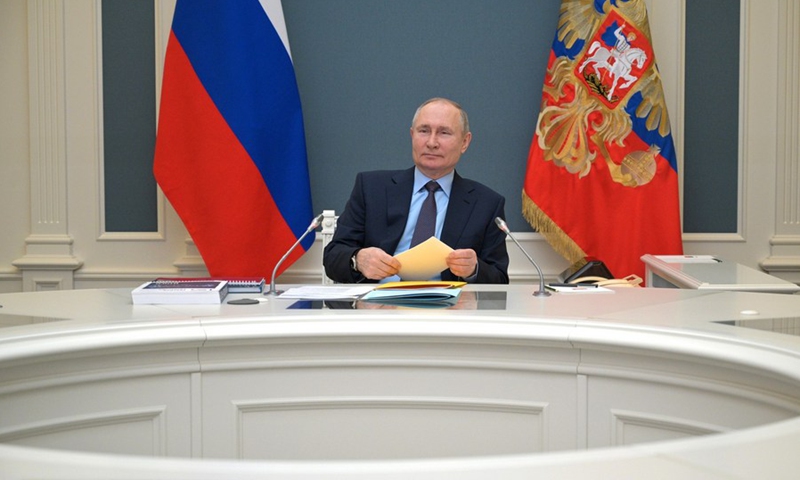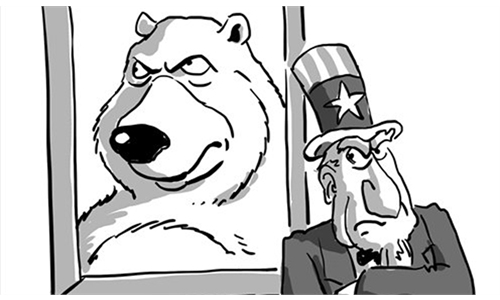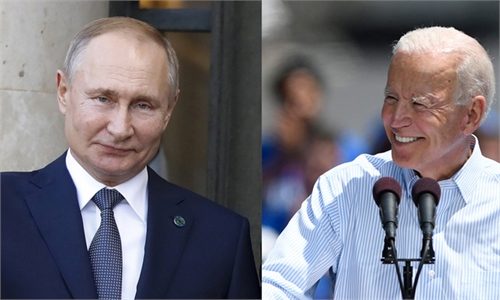
Russian President Vladimir Putin attends a meeting of the Board of Trustees of the Russian Geographical Society via video link on April 14, 2021.(Photo: Xinhua)
The Biden administration has continued the policy of exerting maximum pressure on Russia, with even greater efforts than before. The US and its allies have taken several rounds of sanctions against Russia, trying to force it to yield by precisely attacking key sectors of Russia's economy. However, the long-term sanctions did not achieve the expected effect.Russia has not only survived the most difficult period, but also strengthened its national influence. After US President Joe Biden came to power, US way to pressure Russia has had some changes with focus shifting onto psychological warfare against Russian President Vladimir Putin and the Russian government.
Andrei Ilnitsky, an adviser to Russian defense minister, recently said that the US and other Western countries are waging a psychological war on Russia. The move is similar to the "color revolutions" in the post-Soviet space and the Middle East that took place in the first decade of the century. This might be called color revolution 2.0.
This strategy could first be seen in the largest wave of protests in Russia in recent years triggered by the Russian opposition activist Alexei Navalny's return to the country in early 2021. In fact, most of the people who participated in the protests just wanted to express their dissatisfaction with their government in terms of the epidemic control. Western countries would never give up such an opportunity to exert pressure on Moscow. They thus launched all-round attacks on Russia - through embassies in Russia, they provided supports to protests of the oppositions. Besides, they also manipulated international public opinion against Putin and his government.
These measures are a replica of the previous color revolutions, which led to the downfall of the legitimately elected regimes in those targeted countries with their development there seriously hindered. Facts prove that the color revolutions have never brought about "democracy and freedom." As Biden was elected US president in November 2020, many people worried that a Democratic administration would regain the tool of interventionism, setting off a wave of color revolutions again.
However, times have changed. Western countries are no longer as influential as they were earlier in this century when the global influence of neoliberalism reached its peak. Compared with the emerging countries, they have shown a decline tendency in economic development and social governance. In particular, Western countries have not completely put COVID-19 under control, and are busy enough with their own affairs. Therefore, manipulating public opinion to attack Russia is what the Western can do at best right now.
The mainstream US elites' sense of mission in gaining an upper hand in ideology is returning rapidly. For example, Michael A. McFaul, former US ambassador to Russia, tweeted recently that Russia would be richer and more free under a democratic system rather than under the rule by Putin.
As long-term sanctions against Russia have failed to topple the Putin administration, Western countries actually lack the tools to threaten Russia directly. Therefore, information and psychological wars were launched to demonize Putin's regime.
However, judging from the current facts, the Western countries' intention to initiate a color revolution in Russia has not been realized. After Putin's personal approval rating dropped to the bottom in January 2021, it began to rebound after March. The oppositions' protests did not last long or expand. Opposition leaders' reputation plummeted because they have either been sentenced to imprisonment, or chosen to flee the country, or been identified as proxies of the West to overthrow Russia. The oppositions have thus been opposed by many Russian people.
A more important reason is that: There is no division within the essential part of the Putin administration. The interest groups of all parties maintain unity and stability around Putin. This has weakened the impact of color revolution.
The color revolutions succeeded in Ukraine, Georgia and Kyrgyzstan primarily because of factional rivalry within their ruling groups. In Russia, however, Putin has shown strong leadership and successfully integrated the highly alienated Russian elites. Western countries thus cannot find leverage from within the Russian ruling group. So they can only utilize figures such as Navalny. But this actually weakened the effectiveness of the color revolution.
The stability of the ruling group and the high approval rating are the base for Russia to defend itself against Western countries' attempts to subvert it. Moreover, after Russians experienced the chaos and disorder in the transition era after the collapse of the former Soviet Union in the 1990s, they do not favor any party that wants to destroy the existing order and stability.
After Biden came to power, he has engaged in containment policy against Russia and China. This color revolution 2.0 will not only target Russia; China also needs to stay sharp. But today's color revolution has already lost the endorsement of the West's superiority. As late chairman Mao Zedong put it, we should despise the enemies strategically, but tactically we should take them seriously.
The author is an assistant research fellow from the Centre for Russian Studies, East China Normal University.
The article was translated by Tang Zhiying of East China Normal University.


